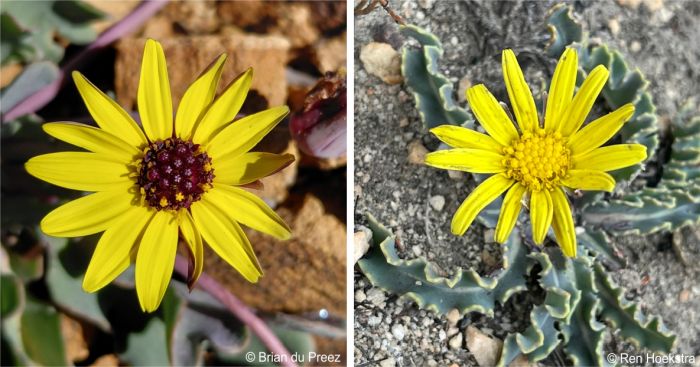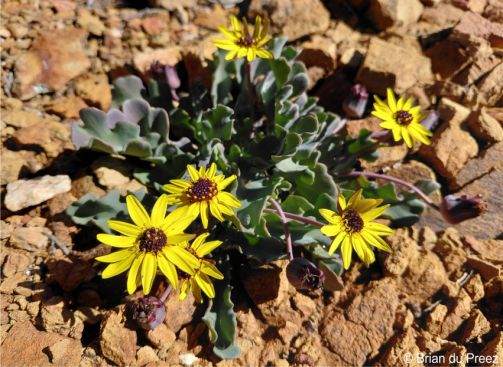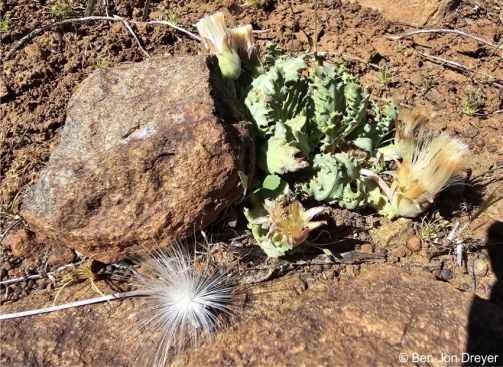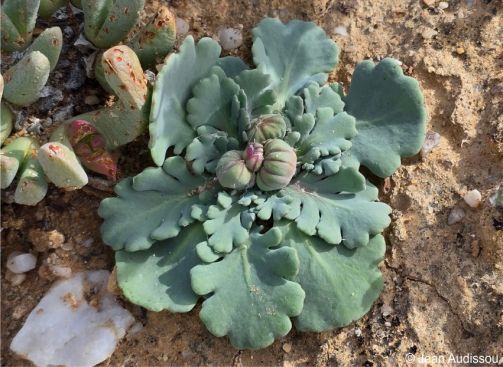Othonna auriculifolia
Othonna auriculifolia Licht. ex Less.
Family: Asteraceae
Common names: lobe-leaf baboon cabbage (Eng.); sandkool, wildepatat (Afr.)
Introduction
A low-growing plant with a rosette of fleshy leaves and bright yellow daisies on erect stems, from the arid interior of southwestern and western South Africa.

Description
Description
Othonna auriculifolia is a stemless or very short-stemmed, deciduous perennial with a tuberous root, growing about 150 to 250 mm tall. The leaves arise directly from the root (radical) forming a basal rosette or a dense clump of leaves at ground level. The leaves are leathery, thick and fleshy, broadly rounded at the tip, with a tapering base, 20-120 mm long and 5-25 mm wide, the blade flat or concave with lobes curled up, the margin toothed to deeply lobed. The flower heads are typical daisy flowers, solitary, 10-30 mm diameter, on stiff peduncles. The ray petals yellow, with undersides often flushed with red or purple. The disc florets yellow or sometimes dark purple. Flowering is in autumn, winter and spring (April to September). The fruit is a cypsela, covered in short soft hairs (pubescent) with a bristly pappus 15-25 mm long.

Conservation Status
Status
Currently assessed as Least Concern (LC) by the Red List of South African Plants, it is not regarded as an endangered species, although habitat loss and climate change pose a potential threat to its natural population.
Distribution and habitat
Distribution description
Othonna auriculifolia is endemic to South Africa, occurring in the Eastern Cape, Western Cape, Northern Cape and Free State, growing on stony clay slopes and flats from the Bokkeveld Escarpment and western Karoo to the Klein Swartberg.

Derivation of name and historical aspects
History
Othonna is a genus in the sunflower family (Asteraceae or Compositae), in the senecioid subdivision of the family. The name Asteraceae is probably derived from the Greek aster that means star. The genus name Othonna is probably from the Greek word othonne, for linen or cloth, referring to the soft leaves of some species. The leaves of this species are thick and fleshy, more or less dorsiventrally flattened with an ear-like shape, hence the species name auriculifolia, meaning leaves like an ear. The Afrikaans name for the genus is bobbejaankool, meaning baboon cabbage, and refers to the resemblance of the leaves to cabbage, and the name for this species, sandkool means sand cabbage, referring to its sandy habitat.
Othonna is a genus of approximately 90 species of succulent or sub-succulent plants. Their leaves are often succulent, elongated, with different shapes, sometimes very decorative. The genus is characterised by the presence of undivided (or minutely bifid) styles in the flower heads. The deciduous species have a woody stem that has the function of a water and nutrient storage organsupply. In general the peculiarities of the stem and the leaves are main reason why so many species of Othonna are so much in demand as ornamental plants. They are part of the family Asteraceae, and are therefore close relatives of sunflowers. They are most similar to Senecio, differing in only few details.

Ecology
Ecology
The natural environment of Othonna auricufolia is arid with little or sporadic rainfall, and these plants have a tuberous root and fleshy leaves that can store water and allow it to thrive in this water-scarce environment. Its flowers feed various bees and other insects, making this plant a crucial player in its ecological system. The seeds are dispersed by wind.

Uses
Use
There are no documented medicinal or cultural uses for Othonna auriculifolia. This plant holds potential as an ornamental plant for dry, winter-rainfall gardens, or as a container specimen.

Growing Othonna auriculifolia
Grow
Othonna auriculifolia grows in arid, temperate, winter-rainfall habitats and therefore needs free-draining, acidic soils with moderate water in autumn, winter and spring, and a dry summer. In general, it prefers a position with sun to half-sun exposure. Best suited to low rainfall, winter-rainfall gardens or containers where conditions can be controlled.
Sow seeds in autumn, in well-drained sandy or loamy mix suitable for succulents, and cover with a sufficient soil to keep them in place. Use a deep tray to allow the plants a season or two to develop before transplanting. Handle with care because they can break easily.
References
- Berger, M. 2021-09. Observation of Othonna auriculifolia, Sutherland, NC. iNaturalist. Online. https://www.inaturalist.org/observations/97484376.
- Dreyer, B.-J. 2024-10. Observation of Othonna auriculifolia, Hantamsberg, NC. iNaturalist. Online. https://www.inaturalist.org/observations/246590747.
- Du Preez, B. 2025-08. Observation of Othonna auriculifolia, Laingsburg, WC. iNaturalist. Online. https://www.inaturalist.org/observations/304259163
- Fox, M. 2025-07. Observation of Othonna auriculifolia, Ceres WC. iNaturalist. Online. https://www.inaturalist.org/observations/296720987.
- Hoekstra, R. 2025-08. Observation of Othonna auriculifolia, Rooiberg Reserve, WC. iNaturalist. Online. https://www.inaturalist.org/observations/308481314.
- Magoswana, S.L., Boatwright, J.S., Magee, A.R. & Manning, J.C. 2022. A taxonomic revision of the Othonna auriculifolia Less. Group (Asteraceae: Senecioneae: Onthonninae). Bothalia 52(1).
- Manning, J. & Goldblatt, P. 2012. Plants of the Greater Cape Floristic Region 1: the Core Cape Flora. Strelitzia 29. South African National Biodiversity Institute, Pretoria.
- Raimondo, D., Von Staden, L., Foden, W., Victor, J.E., Helme, N.A., Turner, R.C., Kamundi, D.A. & Manyama, P.A. (eds) 2009. Red list of South African plants. Strelitzia 25. South African National Biodiversity Institute, Pretoria.
- Stephenson, J. 2025-08. Observation of Othonna auriculifolia, Hex River Mountains, WC. iNaturalist. Online. https://www.inaturalist.org/observations/307291152.
- Vlok, J. & Schutte-Vlok, A.L. 2010. Plants of the Klein Karoo. Umdaus Press, Hatfield.
Credits
Samuel Lekhetho, Free State National Botanical Garden
and Alice Notten, Kirstenbosch National Botanical Garden
September 2025
Acknowledgements: images by Ben-Jon Dreyer, Brian du Preez, Jean Audissou, Jean Stephenson, Margaret Fox, Matt Berger and Ren Hoekstra, from their observations shared on iNaturalist.
Plant Attributes:
Plant Type: Succulent
SA Distribution: Eastern Cape, Free State, Northern Cape, Western Cape
Soil type: Sandy, Clay, Loam
Flowering season: Spring, Autumn, Winter
PH: Acid, Neutral
Flower colour: Black, Yellow
Aspect: Full Sun
Gardening skill: Challenging
Special Features:
Horticultural zones









Rate this article
Article well written and informative
Rate this plant
Is this an interesting plant?
Login to add your Comment
Back to topNot registered yet? Click here to register.